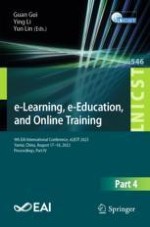2024 | Book
e-Learning, e-Education, and Online Training
9th EAI International Conference, eLEOT 2023, Yantai, China, August 17-18, 2023, Proceedings, Part IV
Editors: Guan Gui, Ying Li, Yun Lin
Publisher: Springer Nature Switzerland
Book Series : Lecture Notes of the Institute for Computer Sciences, Social Informatics and Telecommunications Engineering
